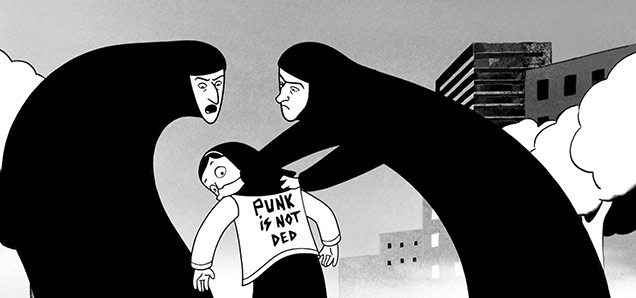Reading Between The Lines: Drawn to Story: The best graphic novels of all time
 CREDIT: MARJANE SATRAPI
CREDIT: MARJANE SATRAPIPersepolis is Maus-like in its artistic simplicity, and just as impactful too.
The term graphic novel almost seems loaded. It is encouraged by some comic fans as a means of separating more meaningful, seriously- written and drawn works from the chaotic noise of superheroes and supervillains. Other decried as the trivializing of comics as a medium of its own, that it needs a grown-up-sounding label in order to be taken more seriously. Both schools of thought of course agree that the medium itself has come a long way since Superman struck his first well-placed punch to stop Lex Luthor’s dastardly schemes. Some of the best works that fall under this dubious label include:
Transmetropolitan (1997-2002)
Written: Warren Ellis
Art: Darick Robertson
Winning much acclaim throughout its five-year run, this collaboration between Warren Ellis and Darick Robertson follows the adventures of Spider Jericho – a 22nd century Hunter S. Thompson-esque madman/journalist – and his fight against the corrupt forces that be and for the truth – mostly by leaving plenty of destruction and chaos in his wake. Transmetropolitan is a ‘90s relic that’s aged surprisingly well, unlike its fellow edgy ‘90s sci-fi counterparts – like The Matrix or eXistenz – it knows how to strike a balance between being goofy and poignant, never losing itself in a cloud of philosophical self-importance. The art, penciled by Darick Robertson, is incredibly rich and detailed, nearly every other frame a game of spot-the-Easter-eggs, bringing the corrupt but campy world of The City to life.
Watchmen (1986-87)
Written: Alan Moore
Art: Dave Gibbons
Don’t even begin to think that the generally agreed upon status of the 2009 adaptation of Watchmen as being decent is enough to truly experience this alternate ‘80s dystopia. While the Snyder adaptation does a competent job of narrating the action- y superhero story in a straightforward manner, the film doesn’t even begin to scrape the surface of this deeply complex tale of the real-world impacts a superhero could bring. Watchmen isn’t merely a series of comic panels with word bubbles; it reveals a greater narrative through an epistolary format, through in-universe journal entries, newspaper clippings, book excerpts and interviews with characters. Regardless of whether the movie entertained you, Watchmen – the graphic novel – is an entirely different beast in itself, less super-shenanigans and more the examination of superheroes as deeply flawed human beings.
From Hell (1989-1996)
Writer: Alan Moore
Art: Eddie Campbell
Fewer graphic novels have captured the dark side of humanity that this collaboration between Alan Moore and Eddie Campbell that lasted eight years in its original run. From Hell chronicles the tale of a special kind of evil: the tale of Jack the Ripper, and the shroud of conspiracy that covered this gruesome serial murderer. The art is stark, harsh ink; giving everything it depicts, from graphic violence to sexuality, a look of deliberate uncleanliness and ugliness.
Persepolis (2000)
Writer/Art: Marjane Satrapi
This French graphic novel serves as an autobiography for writer Marjane Satrapi’s coming-of-age in post-revolutionary Iran. The book stays close to its roots without alienating whatever audience may be reading it, making as relatable as My Girl but far more poignant and less emotionally cheaper too. Satrapi’s high-contrast trichrome art style carries simplistic yet expressive character designs.













